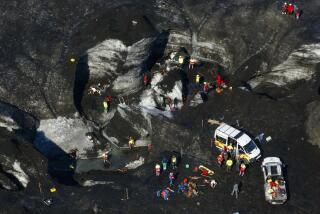Iceland’s History Memorialized by Sagas : Culture: Ancient manuscripts are to these northern folk what castles and monuments are topeople of other nations.
- Share via
REYKJAVIK, Iceland — Iceland has neither castles nor chateaux nor monuments. Instead it has sagas, lively legends that chronicle the settlement of the North Atlantic island.
From childhood, Icelanders are schooled in stories that were written in the 12th to 14th centuries, and they are as indelible in their minds, conversation and art as the bearberry ink used to write the originals on vellum.
Writer and filmmaker Hrafn Gunnlaugsson often draws inspiration from the memory of sagas his grandmother told him when he was a child.
“It runs in my blood,” he says. “I am a storyteller, and I was brought up in Iceland. It is my image, it is where I come from.”
The legends begin with the 9th-Century Viking settlement of Iceland. The writing is spare but vigorous, describing a golden age of heroism, independence and achievement.
Among the leather-bound volumes protected in a vault in the capital city’s Arni Magnusson Institute are “The Book of Icelanders,” a history of the nation to about 1130, and “The Vinland Sagas,” which tell of the Norse exploration of America centuries before Christopher Columbus.
Jonas Kristjansson, institute director, says the stories are cherished in the way other nations revere their monuments.
“The Icelandic people have very few visible memorials of their illustrious past. There are no ancient buildings and very few medieval antiquities. The manuscripts are to the Icelanders what castles and royal palaces are to other nations,” Kristjansson said.
The sagas are commonly available in bookstores in Icelandic and English and are often given as gifts, especially to mark a confirmation or graduation.
Because the language has changed little, sagas are easily understood by today’s readers. Icelandic has been called “the Latin of the north” because of its purity.
Magnus Magnusson, a writer and broadcaster of Icelandic descent who lives in Scotland, says the sagas form “a literary gene bank.”
“It has global significance, and at the same time it is a bloody good read. They pierce some of the fundamentals of human dilemmas, honor, courage, honesty, greed, covetousness and cowardice,” Magnusson said.
One of his favorites was about a boy who went to see the Earl of Norway. He had a boil on his foot, and with each step blood and pus oozed. When the earl asked the boy why he did not limp, he replied: “Men do not limp while their legs are the same length.”
“My mother used to tell me that when I came in with a grazed knee,” Magnusson said, and the story resonates for him today when he confronts trouble.
The sagas also record the routine--property ownership, weather, laws and diet.
It is written that drifting polar ice sometimes forced a whale ashore, providing a welcome addition to the larder. To this day, Icelanders call an unexpected piece of good luck a “whale drift.”
During the last two centuries, scholars all over Europe and North America have studied the sagas and translated them into their own languages.
The tales, many based on fact but enlivened in the writing, have been helpful to Scandinavians as they piece together Norse history. An English climatologist used the sagas to determine weather patterns in Iceland. Poets including W. H. Auden have been inspired by them.
Feminism is strong in Iceland, and its roots run deep in the sagas, which often portray strong women against the backdrop of a violent men’s world.
Tragic and passionate, “The Laxdaela Saga” is dominated by two women--the matriarchal Unn and the tempestuous Gudrun.
Other sagas feature Breeches-Aud, dressed in a man’s clothes, avenging her husband’s disloyalty with a sword, and Thorbjorge the Stout, who protects an outlaw from a mob. When her husband asks how she could so embarrass him in front of the neighbors, she says: “They will think that you should be proud to have a wife who had the courage to do such a thing, and that he must be a great chief whose wife is so free.”
Visiting Americans are reminded that the sagas record the presence of an Icelander in their country in 985 or 986, well before Columbus set foot in the Caribbean in 1492.
The sagas describe how a young merchant named Bjarni Herjolfsson, bound for an Icelandic colony in western Greenland, was blown off course, southwest across the Atlantic, and sighted unknown lands.
Fifteen years later Leif the Lucky returned to the New World.
There he found towering timber, an abundance of game, rivers choked with giant salmon, fields of wheat and wild grapes in profusion.
He called the country Vinland, the land of grapes.
But the name didn’t stick, Magnusson says (with apologies to Oscar Wilde), because “Icelanders had the good sense to find America then keep quiet about it.”
More to Read
Sign up for Essential California
The most important California stories and recommendations in your inbox every morning.
You may occasionally receive promotional content from the Los Angeles Times.













